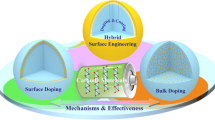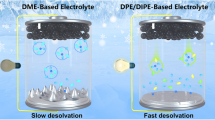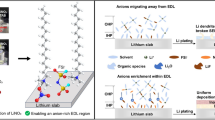Abstract
Nowadays, the majority of the studies on the substitution are focused on cations (such as Y3+, Ti4+, P5+, etc.) in Li1.3Al0.3Ti1.7(PO4)3 (LATP), while there are few studies on the substitution of anion O2−. In this work, the modified LATP with a series of LiCl (LATPClx, x = 0.1, 0.2, 0.3, 0.4) additives is prepared to enhance ionic conductivity. The successful introduction of Cl− makes the length of the c axis decrease from 20.822(2) to 20.792(1) Å, and the bulk conductivity of 2.13 × 10−3 S·cm−1 is achieved in LATPCl0.3. Moreover, the Al/Ti-O1/Cl1 and Al/Ti-O2/Cl2 distance decrease, while the Li1-O2/Cl2 distance increases. Lithium ions migrate more easily in the nanochannel of M3-M1-M3. In addition, the LiCl additive increases the relative density and the grain boundary conductivity of LATPClx compounds. Naturally, a higher ionic conductivity of 2.12 × 10−4 S·cm−1 and a low activation energy of 0.30 eV are obtained in LATPCl0.3. Correspondingly, the symmetric cell exhibits a low overpotential of ±50 mV for over 200 h in LATPCl0.3. The solid-state Li∣LATPCl0.3∣NCM811 (NCM811 = LiNi0.8Co0.1Mn0.1O2) battery exhibits high initial capacity 185.1 mAh·g−1 with a capacity retention rate of 95.4% after 100 cycles at 0.5 C. This result suggests that LiCl additive is an effective strategy to promote electrochemical properties of LATP solid electrolyte and can be considered for reference to other inorganic solid electrolytes systems.

Similar content being viewed by others
References
Jin, C. Y.; Fan, S. J.; Zhuang, Z. C.; Zhou, Y. S. Single-atom nanozymes: From bench to bedside. Nano Res. 2023, 16, 1992–2002.
Liu, Z. H.; Du, Y.; Zhang, P. F.; Zhuang, Z. C.; Wang, D. S. Bringing catalytic order out of chaos with nitrogen-doped ordered mesoporous carbon. Matter 2021, 4, 3161–3194.
Hao, J. C.; Zhu, H.; Zhuang, Z. C.; Zhao, Q.; Yu, R. H.; Hao, J. C.; Kang, Q.; Lu, S. L.; Wang, X. F.; Wu, J. S. et al. Competitive trapping of single atoms onto a metal carbide surface. ACS Nano 2023, 17, 6955–6965.
Hao, J. C.; Zhuang, Z. C.; Hao, J. C.; Cao, K. C.; Hu, Y. X.; Wu, W. B.; Lu, S. L.; Wang, C.; Zhang, N.; Wang, D. S. et al. Strain relaxation in metal alloy catalysts steers the product selectivity of electrocatalytic CO2 reduction. ACS Nano 2022, 16, 3251–3263.
Li, S. D.; Zhuang, Z. C.; Xia, L. X.; Zhu, J. X.; Liu, Z. A.; He, R. H.; Luo, W.; Huang, W. Z.; Shi, C. W.; Zhao, Y. et al. Improving the electrophilicity of nitrogen on nitrogen-doped carbon triggers oxygen reduction by introducing covalent vanadium nitride. Sci. China Mater. 2023, 66, 160–168.
Kang, Q.; Zhuang, Z. C.; Li, Y.; Zuo, Y. Z.; Wang, J.; Liu, Y. J.; Shi, C. Q.; Chen, J.; Li, H. F.; Jiang, P. K. et al. Manipulating dielectric property of polymer coatings toward high-retention-rate lithium metal full batteries under harsh critical conditions. Nano Res., in press, https://doi.org/10.1007/s12274-023-5478-4.
Hu, B.; Xu, J.; Fan, Z. J.; Xu, C.; Han, S. C.; Zhang, J. X.; Ma, L. B.; Ding, B.; Zhuang, Z. C.; Kang, Q. et al. Covalent organic framework based lithium-sulfur batteries: Materials, interfaces, and solid-state electrolytes. Adv. Energy Mater. 2023, 13, 2203540.
Li, Q.; Sun, X.; Cao, D. X.; Wang, Y.; Luan, P. C.; Zhu, H. L. Versatile electrospinning for structural designs and ionic conductor orientation in all-solid-state lithium batteries. Electrochem. Energy Rev. 2022, 5, 18.
Zhuang, Z. C.; Li, Y. H.; Yu, R. H.; Xia, L. X.; Yang, J. R.; Lang, Z. Q.; Zhu, J. X.; Huang, J. Z.; Wang, J. O.; Wang, Y. et al. Reversely trapping atoms from a perovskite surface for high-performance and durable fuel cell cathodes. Nat. Catal. 2022, 5, 300–310.
Liu, Z. H.; Du, Y.; Yu, R. H.; Zheng, M. B.; Hu, R.; Wu, J. S.; Xia, Y. Y.; Zhuang, Z. C.; Wang, D. S. Tuning mass transport in electrocatalysis down to sub-5 nm through nanoscale grade separation. Angew. Chem., Int. Ed. 2023, 62, e202212653.
Xiao, W.; Wang, J. Y.; Fan, L. L.; Zhang, J. J.; Li, X. F. Recent advances in Li1+xAlxTi2−x(PO4)3 solid-state electrolyte for safe lithium batteries. Energy Storage Mater. 2019, 19, 379–400.
Zhang, P.; Wang, H.; Lee, Y. G.; Matsui, M.; Takeda, Y.; Yamamoto, O.; Imanishi, N. Tape-cast water-stable NASICON-type high lithium ion conducting solid electrolyte films for aqueous lithium-air batteries. J. Electrochem. Soc. 2015, 162, A1265–A1271.
Li, X.; Guan, Q. H.; Zhuang, Z. C.; Zhang, Y. Z.; Lin, Y. H.; Wang, J.; Shen, C. Y.; Lin, H. Z.; Wang, Y. L.; Zhan, L. et al. Ordered mesoporous carbon grafted MXene catalytic heterostructure as Li-ion kinetic pump toward high-efficient sulfur/sulfide conversions for Li-S battery. ACS Nano 2023, 17, 1653–1662.
Singh, M. D.; Dalvi, A.; Phase, D. M.; Kumar, Y. Li1.3Al0.3Ti1.7(PO4)3 reinforced hybrid polymer composites: Assessment of enhanced Li+ ion transport and potential for solidstate supercapacitor applications. J. Mater. Sci. 2020, 55, 3951–3963.
Monchak, M.; Hupfer, T.; Senyshyn, A.; Boysen, H.; Chernyshov, D.; Hansen, T.; Schell, K. G.; Bucharsky, E. C.; Hoffmann, M. J.; Ehrenberg, H. Lithium diffusion pathway in Li1.3Al0.3Ti1.7(PO4)3 (LATP) superionic conductor. Inorg. Chem. 2016, 55, 2941–2945.
Jiang, J. Z.; Bai, S. S.; Zou, J.; Liu, S.; Hsu, J. P.; Li, N.; Zhu, G. Y.; Zhuang, Z. C.; Kang, Q.; Zhang, Y. Z. Improving stability of MXenes. Nano Res. 2022, 15, 6551–6567.
Qian, H. M.; Ren, H. Q.; Zhang, Y.; He, X. F.; Li, W. B.; Wang, J. J.; Hu, J. H.; Yang, H.; Sari, H. M. K.; Chen, Y. et al. Surface doping vs. bulk doping of cathode materials for lithium-ion batteries: A review. Electrochem. Energy Rev. 2022, 5, 2.
Kang, Q.; Li, Y.; Zhuang, Z. C.; Wang, D. S.; Zhi, C. Y.; Jiang, P. K.; Huang, X. Y. Dielectric polymer based electrolytes for highperformance all-solid-state lithium metal batteries. J. Energy Chem. 2022, 69, 194–204.
Zhang, S. N.; Sun, Q.; Hou, G. M.; Cheng, J.; Dai, L. N.; Li, J. W.; Ci, L. J. Boosting fast interfacial Li+ transport in solid-state Li metal batteries via ultrathin Al buffer layer. Nano Res. 2023, 16, 6825–6832.
Zhuang, Z. C.; Xia, L. X.; Huang, J. Z.; Zhu, P.; Li, Y.; Ye, C. L.; Xia, M. G.; Yu, R. H.; Lang, Z. Q.; Zhu, J. X. et al. Continuous modulation of electrocatalytic oxygen reduction activities of singleatom catalysts through p-n junction rectification. Angew. Chem., Int. Ed. 2023, 62, e202212335.
Rosenberger, A.; Gao, Y.; Stanciu, L. Field-assisted sintering of Li1.3Al0.3Ti1.7(PO4)3 solid-state electrolyte. Solid State Ionics 2015, 278, 217–221.
Zhao, E. Q.; Ma, F. R.; Guo, Y. D.; Jin, Y. C. Stable LATP/LAGP double-layer solid electrolyte prepared via a simple dry-pressing method for solid state lithium ion batteries. RSC Adv. 2016, 6, 92579–92585.
Li, X. Y.; Zhuang, Z. C.; Chai, J.; Shao, R. W.; Wang, J. H.; Jiang, Z. L.; Zhu, S. W.; Gu, H. F.; Zhang, J.; Ma, Z. T. et al. Atomically strained metal sites for highly efficient and selective photooxidation. Nano Lett. 2023, 23, 2905–2914.
Ślubowska, W.; Montagne, L.; Lafon, O.; Méar, F.; Kwatek, K. B2O3-doped LATP glass-ceramics studied by X-ray diffractometry and MAS NMR spectroscopy methods. Nanomaterials 2021, 11, 390.
Lu, P. S.; Wu, D. X.; Chen, L. Q.; Li, H.; Wu, F. Air stability of solid-state sulfide batteries and electrolytes. Electrochem. Energy Rev. 2022, 5, 3.
Zhuang, Z. C.; Li, Y.; Li, Y. H.; Huang, J. Z.; Wei, B.; Sun, R.; Ren, Y. J.; Ding, J.; Zhu, J. X.; Lang, Z. Q. et al. Atomically dispersed nonmagnetic electron traps improve oxygen reduction activity of perovskite oxides. Energy Environ. Sci. 2021, 14, 1016–1028.
Zhu, H.; Sun, S. H.; Hao, J. C.; Zhuang, Z. C.; Zhang, S. G.; Wang, T. D.; Kang, Q.; Lu, S. L.; Wang, X. F.; Lai, F. L. et al. A highentropy atomic environment converts inactive to active sites for electrocatalysis. Energy Environ. Sci. 2023, 16, 619–628.
Fan, M. X.; Deng, X. Y.; Zheng, A. Q.; Yuan, S. D. Solvothermal synthesis high lithium ionic conductivity of Gd-doped Li1.3Al0.3Ti1.7(PO4)3 solid electrolyte. Funct. Mater. Lett. 2021, 14, 2140002.
Kothari, D. H.; Kanchan, D. K. Inter-grain Li+ conduction in Sc and Y doped LATP compounds. Phys. B: Condens. Matter 2022, 627, 413599.
Zhu, J. P.; Xiang, Y. X.; Zhao, J.; Wang, H. C.; Li, Y. X.; Zheng, B. Z.; He, H. J.; Zhang, Z. R.; Huang, J. Y.; Yang, Y. Insights into the local structure, microstructure and ionic conductivity of silicon doped NASICON-type solid electrolyte Li1.3Al0.3Ti1.7P3O12. Energy Storage Mater. 2022, 44, 190–196.
Wang, Q. H.; Liu, L.; Zhao, B. J.; Zhang, L.; Xiao, X.; Yan, H.; Xu, G. L.; Ma, L.; Liu, Y. Transport and interface characteristics of Te-doped NASICON solid electrolyte Li1.3Al0.3Ti1.7(PO4)3. Electrochim. Acta 2021, 399, 139367.
Cai, Z. H.; Huang, Y.; Zhu, W. C.; Xiao, R. G. Increase in ionic conductivity of NASICON-type solid electrolyte Li1.5Al0.5Ti1.5(PO4)3 by Nb2O5 doping. Solid State Ionics 2020, 354, 115399.
Kızılaslan, A.; Kırkbınar, M.; Cetinkaya, T.; Akbulut, H. Sulfur doped Li1.3Al0.3Ti1.7(PO4)3 solid electrolytes with enhanced ionic conductivity and a reduced activation energy barrier. Phys. Chem. Chem. Phys. 2020, 22, 17221–17228.
Shen, K.; Cao, Z. J.; Shi, Y. Z.; Zhang, Y. Z.; Li, B.; Yang, S. B. 3D printing lithium salt towards dendrite-free lithium anodes. Energy Storage Mater 2021, 35, 108–113.
Kwatek, K.; Ślubowska, W.; Trébosc, J.; Lafon, O.; Nowiński, J. L. Structural and electrical properties of ceramic Li-ion conductors based on Li1.3Al0.3Ti1.7(PO4)3-LiF. J. Eur. Ceram. Soc. 2020, 40, 85–93.
Xiong, L. L.; Ren, Z. H.; Xu, Y. L.; Mao, S. C.; Lei, P.; Sun, M. T. LiF assisted synthesis of LiTi2(PO4)3 solid electrolyte with enhanced ionic conductivity. Solid State Ionics 2017, 309, 22–26.
Aono, H.; Sugimoto, E.; Sadaoka, Y.; Imanaka, N.; Adachi, G. Y. Ionic conductivity of solid electrolytes based on lithium titanium phosphate. J. Electrochem. Soc. 1990, 137, 1023–1027.
Hupfer, T.; Bucharsky, E. C.; Schell, K. G.; Senyshyn, A.; Monchak, M.; Hoffmann, M. J.; Ehrenberg, H. Evolution of microstructure and its relation to ionic conductivity in Li1+xAlxTi2−x(PO4)3. Solid State Ionics 2016, 288, 235–239.
Arbi, K.; Hoelzel, M.; Kuhn, A.; García-Alvarado, F.; Sanz, J. Local structure and lithium mobility in intercalated Li3AlxTi2−x(PO4)3 NASICON type materials: A combined neutron diffraction and NMR study. Phys. Chem. Chem. Phys. 2014, 16, 18397–18405.
Zhang, B. K.; Lin, Z.; Dong, H. F.; Wang, L. W.; Pan, F. Revealing cooperative Li-ion migration in Li1+xAlxTi2−x(PO4)3 solid state electrolytes with high Al doping. J. Mater. Chem. A 2020, 8, 342–348.
Nakamura, M.; Song, M. B.; Ito, M. Hydrogen bonding between a water molecule and electronegative additives (O or Cl−) on a Pt(111) surface. Chem. Phys. Lett. 2000, 320, 381–386.
Li, S. Y.; Huang, Z. Y.; Xiao, Y. G.; Sun, C. W. Chlorine-doped Li1.3Al0.3Ti1.7(PO4)3 as an electrolyte for solid lithium metal batteries. Mater. Chem. Front. 2021, 5, 5336–5343.
Zhang, B. K.; Tan, R.; Yang, L. Y.; Zheng, J. X.; Zhang, K. C.; Mo, S. J.; Lin, Z.; Pan, F. Mechanisms and properties of ion-transport in inorganic solid electrolytes. Energy Storage Mater. 2018, 10, 139–159.
Ślubowska, W.; Kwatek, K.; Jastrzębski, C.; Nowiński, J. L. Thermal, structural and electrical study of boron-incorporated LATP glasses and glass-ceramics. Solid State Ionics 2019, 335, 129–134.
Liu, Y.; Bai, Q.; Nolan, A. M.; Zhou, Y. N.; Wang, Y. G.; Mo, Y. F.; Xia, Y. Y. Lithium ion storage in lithium titanium germanate. Nano Energy 2019, 66, 104094.
Dashjav, E.; Ma, Q. L.; Xu, Q.; Tsai, C. L.; Giarola, M.; Mariotto, G.; Tietz, F. The influence of water on the electrical conductivity of aluminum-substituted lithium titanium phosphates. Solid State Ionics 2018, 321, 83–90.
Huang, Y.; Jiang, Y.; Zhou, Y. X.; Hu, Z. W.; Zhu, X. H. Influence of liquid solutions on the ionic conductivity of Li1.3Al0.3Ti1.7(PO4)3 solid electrolytes. ChemElectroChem 2019, 6, 6016–6026.
Golosov, O. A.; Khvostov, S. S.; Glushkova, N. V.; Evseev, M. V.; Staritsyn, S. V.; Zaikov, Y. P.; Kovrov, V. A.; Nikitina, E. V.; Kholkina, A. S.; Kazakovtseva, N. A. et al. Corrosive and mechanical resistance of MgO ceramics under metallizing and mild chlorination of spent nuclear fuel in molten salts. Ceram. Int. 2021, 47, 3306–3311.
Dai, L. J.; Wang, J.; Shi, Z. X.; Yu, L. N.; Shi, J. Influence of LiBF4 sintering aid on the microstructure and conductivity of LATP solid electrolyte. Ceram. Int. 2021, 47, 11662–11667.
Krasnikova, I. V.; Pogosova, M. A.; Sanin, A. O.; Stevenson, K. J. Toward standardization of electrochemical impedance spectroscopy studies of Li-ion conductive ceramics. Chem. Mater. 2020, 32, 2232–2241.
Yen, P. Y.; Lee, M. L.; Gregory, D. H.; Liu, W. R. Optimization of sintering process on Li1+xAlxTi2−xPO4)3 solid electrolytes for all-solid-state lithium-ion batteries. Ceram. Int. 2020, 46, 20529–20536.
Lee, K. C.; Chang-Jian, C. W.; Ho, B. C.; Ding, Y. R.; Huang, J. H.; Hsiao, Y. S. Conductive PProDOT-Me2-capped Li4Ti5O12 microspheres with an optimized Ti3+/Ti4+ ratio for enhanced and rapid lithium-ion storage. Ceram. Int. 2019, 45, 15252–15261.
Yu, K.; Tian, Y.; Gu, R.; Jin, L.; Ma, R. P.; Sun, H. C.; Xu, Y. L.; Xu, Z.; Wei, X. Y. Ionic conduction, colossal permittivity and dielectric relaxation behavior of solid electrolyte Li3xLa2/3−xTiO3 ceramics. J. Eur. Ceram. Soc. 2018, 38, 4483–4487.
Chen, D.; Yang, J. L.; Zhou, Y. Y.; Xie, H.; Zhang, H. H.; Lai, H. R. Divalent-doped Li1.3Al0.3Ti1.7(PO4)3 ceramics with enhanced microwave absorption properties in the X-band. J. Electron. Mater. 2022, 51, 2663–2672.
Liu, C.; Wang, H. R.; Long, T.; Ma, Q.; Ning, P.; Dong, X. R.; Zhou, C. S.; Wu, X. W.; Zeng, X. X. Borosilicate glass-enabled antifracture NASICON solid electrolytes for lithium-metal batteries. ACS Appl. Energy Mater. 2022, 5, 3734–3740.
Feng, W. L.; Yang, P.; Dong, X. L.; Xia, Y. Y. A low temperature soldered all ceramic lithium battery. ACS Appl. Mater. Interfaces 2022, 14, 1149–1156.
Kang, J. R.; Gu, R.; Guo, X.; Li, J.; Sun, H. C.; Zhang, L. Y.; Jing, R. Y.; Jin, L.; Wei, X. Y. Effect of SnO-P2O5-MgO glass addition on the ionic conductivity of Li1.3Al0.3Ti1.7(PO4)3 solid electrolyte. Ceram. Int. 2022, 48, 157–163.
Acknowledgements
This work was supported by the National Natural Science Foundation of China (NSFC) (Nos. 51772239, 51972262 and 22005186) and the 111 Project (No. B14040). The SEM work was done at the International Center for Dielectric Research (ICDR), Xi’an Jiaotong University, Xi’an, China.
Author information
Authors and Affiliations
Corresponding authors
Electronic Supplementary Material
Rights and permissions
About this article
Cite this article
Kang, J., Guo, X., Gu, R. et al. Enhanced electrochemical performance of Li1.3Al0.3Ti1.7(PO4)3 solid electrolyte by anion doping. Nano Res. 17, 1465–1472 (2024). https://doi.org/10.1007/s12274-023-5890-9
Received:
Revised:
Accepted:
Published:
Issue Date:
DOI: https://doi.org/10.1007/s12274-023-5890-9




